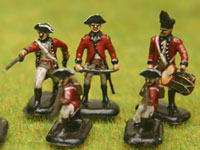Black Women and the Revolution
Hope Smith of Colonial Williamsburg talks about the work and fate of black women who followed the British army during the American Revolution, hoping to find their freedom.
Hope Smith of Colonial Williamsburg talks about the work and fate of black women who followed the British army during the American Revolution, hoping to find their freedom.
Stewart Pittman, a military interpreter at Colonial Williamsburg, talks about the city's Powder Magazine, looking particularly at the Boys' Company, a group of young men who broke into the magazine in order to steal muskets for drilling for participation in the American Revolution.
Chris Geist, a historic interpreter with the military program staff at Colonial Williamsburg, describes the historical function of the city's powder magazine, during the colonial era and the American Revolution.
The Civil War may have ended in 1865, but vivid memories of the "Lost Cause" lived on for decades at the Confederate Soldiers Home of Missouri. Opened in 1891, the Confederate Home provided refuge to more than 1,600 veterans and their families for nearly 60 years. These veterans hailed from points throughout the South and served in every major battle of the Civil War. Foot soldiers, artillery and cavalrymen, marines, guerilla fighters, and even spies found a place of rest here in their old age. The very last of these former rebel soldiers, John T. Graves, died at the home in 1950 at the age of 108, thus bringing an end to an era in Missouri history. Today, visitors to the Confederate Memorial State Historic Site can venture to the locations of the former home buildings and stroll through the restored 106-year-old chapel and historic cemetery. Three other historic buildings can be viewed from outside. Interpretive exhibits tell the story of the state's Confederate Soldiers Home.
The site offers exhibits and tours.
NBC's Ann Curry interviews the author of Gettysburg: A Testing of Courage about the strategies and the combat at the Battle of Gettysburg.

Why did armies, during the American Revolution and at other times, fight with lines of men standing near each other? Why did they not simply fight from behind cover?
The use of linear formations in European army infantries was one element of what military historians have called the "Military Revolution," though they have disagreed on the period within early modern history—the Hundred Years' War (13371453), 15501660, or 16601720—during which the tactic became most significant.
In linear formations, infantry troops, armed beginning in the late 17th century with bayoneted flintlock muskets, marched in columns until they were ordered by commanders to form lines, usually three-to-five men in depth, and charge enemy targets while firing in unison. The tactic did not require skilled marksmanship or out-of-the-ordinary heroics, but relied instead on well-drilled and disciplined soldiers delivering massive amounts of firepower.
Line charges, especially when accompanied by artillery fire that arrived at enemy lines just as the advancing soldiers came into firing range, could be decisive in battle. Defending armies, arranged in similarly cohesive lines, could respond with corresponding volleys of ammunition and fend off larger forces. Army size was greatly increased due to the institutionalization of linear formations within a framework of centralized bureaucratic organization, as was the impact of the military on societies.
Historian Guy Chet has discredited a popular "Americanization thesis" that attributed colonists in militias during the late 17th and early 18th centuries with adopting guerrilla warfare tactics learned in battles with Indians as more appropriate than linear formations for fighting in wilderness terrains. Chet finds a lack of evidence for the claim and maintains that contrary to popular belief, the initial victories of American forces in the first battles of the War of Independence were not due to so-called American tactics, but from the failure of the British forces to adhere to established tactics and strategies.
While guerrilla warfare did break out in the backcountry of the South during the final year of the Revolutionary War, both sides for the most part engaged in battles fought according to tactics developed during the Military Revolution.
Clifford J. Rogers, ed., The Military Revolution Debate: Readings on the Military Transformation of Early Modern Europe. Boulder: Westview Press, 1995.
Jeremy Black, European Warfare, 16601815. New Haven: Yale University Press, 1994.
Guy Chet, Conquering the American Wilderness: The Triumph of European Warfare in the Colonial Northeast. Amherst and Boston: University of Massachusetts Press, 2003.
World War II veteran Gustavus R. Ide, Jr. shares his personal memories of the war.
World War II veteran John Laukkanen shares his personal memories of the war.
World War II veteran Bob Doherty shares his personal memories of the war.

This collection presents video and audio oral histories and additional material from American veterans of 20th-century wars. Materials include memoirs (some lengthy), letters, diaries, photo albums, scrapbooks, poetry, artwork, and official documents. The website currently provides digital materials from 4,351 veterans from World War I, World War II, the Korean War, the Vietnam War, the Persian Gulf War, Afghanistan and the Iraq War, and other similar events. The 226 video interviews range from 25 minutes to two hours in length.
The material presented is part of a rapidly growing archive, the Veterans History Project, created by Congress in 2000 to collect stories from the 19 million living veterans. Other sections highlight World War I; World War II's forgotten theaters in China, Burma, and India; and 37 other unique war experiences.